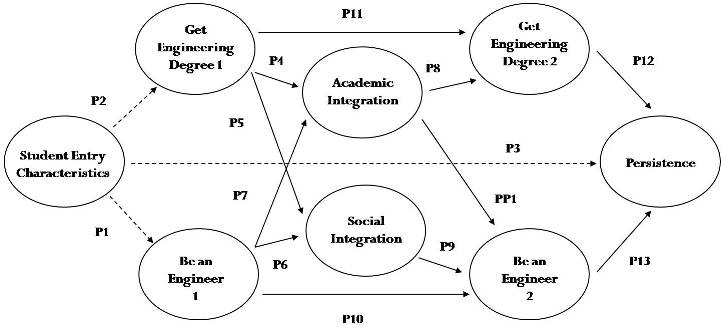Keywords: undergraduate, pathways, persistence, commitment
The Impact of Professional Goals on Students’ Educational Experiences:
A Longitudinal Case Study from Engineering
This study qualitatively examined different paths to persistence in an undergraduate engineering program and how
students experience these paths as they progress through four years of traditional education. Inductive data analysis
from interviews with four students over 4 years supports persistence based on both intrinsic and extrinsic commitments
to engineering – although the students with high intrinsic interest in engineering had a more positive overall
experience.
| By increasing the varieties of teaching and learning activities, perhaps more students will develop
deeper interests and increased commitment to engineering.
|
Implications of Findings
Though the four student experiences analyzed in this study were very different, all four students persisted in
engineering. This suggests there is not a one-size-fits-all solution to retaining engineering students. By
demonstrating that there are multiple pathways to persistence, this study offers insight into attracting and
retaining students. Engineering is a diverse field that provides room for students with many different life goals
and end intentions. By increasing the varieties of teaching and learning activities, perhaps more students will
develop deeper interests and increased commitment to engineering.
Methods and Background
CAEE represents the collaboration of a cross-institutional group of scholars collectively examining three main
elements of engineering education including the Scholarship of Learning Engineering. The Academic Pathways Study
(APS) represents a significant subset of this research, of which this study is a part. This study uses the
semi-structured interview data from one campus ("TPub") in a multi-case, qualitative analysis. Multi-case research
allowed for deeper exploration of, and additional context for, individual cases. This study incorporated
definitions for “case” into the analysis; the bounds for this study are two male and two female engineering students
at TPub from Fall 2003 to Spring 2007. Each case is analyzed separately before all are analyzed together.
For APS, TPub students were recruited through a variety of methods and volunteers were paid to participate. For the
current analysis, four of the eight students in a “high contact” subset of participants were selected to represent
extremes in attitude and coping strategies.
This analysis used semi-structured interviews as the primary data source. Starting in their first year, each
participant was interviewed in the spring semester. Interviews were conducted annually for four years by one of
two interviewers. The interview protocol included a loosely structured framework of guiding questions prompting the
students to think about topics central to the overall APS objectives in case such topics did not rise naturally in
conversation. Interviews were audio-recorded, transcribed, and coded using Atlas Ti software. Patterns and themes
were inductively developed on an individual basis and then compared across cases.
What We Found
All four students examined in this analysis were committed to and persisted in engineering studies as evidenced by
completing engineering degrees during the four-year study. However, their paths to persistence were different.
Results for each of the four students are summarized below:
Max: Although Max was interested in and excited about his major, he was primarily driven by financial
incentives. He was not very socially engaged and his primary academic engagement, beyond classes, was through
internships. While he truly enjoyed his internships, his other academic experiences were not as positive.
Joe: Joe was motivated towards engineering because it embodied many of the things he enjoyed doing as
hobbies. He was highly academically and moderately socially engaged with TPub. Overall, he enjoyed his classroom
and campus experience.
Hillary: Hillary wanted to be an engineer because she was excited about the things she believes engineers
do. Her internship experiences have helped reinforce and shape this belief. Hillary was also highly academically
and highly socially integrated with campus. Throughout her interviews, positive experiences outweighed negative
experiences.
Anna: Anna wanted to get an engineering degree although she was not sure she wanted to be an engineer. She
was moderately socially involved in the campus and highly academically involved, although her involvement was mainly
through the effort she extended in her classes. Although there were positive points, Anna had an overall negative
experience at TPub.
Students’ pathways to persistence are illustrated by Figure 1 below, an adaption of Braxton, Sullivan and Johnson’s
(1997) schematic of the primary elements of pathways to persistence, adapted to this particular study of engineering
students. The two primary paths in this configuration – being an engineer vs. getting an engineering degree – arose
inductively from the data. Hillary and Joe are motivated by the sheer joy of being engineers (intrinsically) while
Max and Anna are primarily extrinsically motivated (e.g., by financial concerns or as a doorway to other careers).

The different professional goals and associated paths to persistence are also associated with the affective nature of
students’ experiences at TPub in addition to academic and social engagement as shown in the student summaries above.
These results suggest that students who are intrinsically interested in being engineers have a more positive classroom
experience than those who have an extrinsic drive towards engineering and have a primary objective of getting an
engineering degree.
Authors: Holly Matusovich, Ruth Streveler, and Heidi Loshbaugh
Source: Paper presented at the 2008 American Educational Research Association Annual Conference
For a printable pdf of this research brief, click here.
Brief created April 2009
Back to Research Briefs
